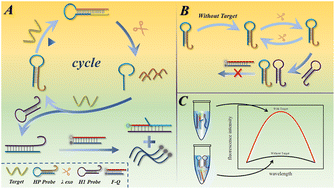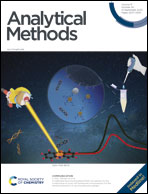Biosensor model based on single hairpin structure for highly sensitive detection of multiple targets†
Abstract
Nowadays, due to the genetic information carried by nucleic acids, they can serve as a biomarker for the early diagnosis of diseases, including tumors and cardiovascular disease, among others, making genetic testing a hotspot of biomedicine. Therefore, we have designed a universal fluorescence biosensor that can detect multiple DNA sequences with good performance. In our designed biosensor, λ exonuclease is used due to its ability to digest double-stranded DNA from the phosphorylated 5′- end and promote the targeted cycle. The exonuclease is introduced into a DNA hairpin containing a target recognition sequence. Hence, with the target, λ exonuclease-assisted targeted recycling can be activated. The hydrolyzed DNA hairpin triggers a strand displacement reaction between the hairpin probe (H1) and F-Q double DNA strand (F-Q), increasing the distance between the fluorescent chain (F) and quenching chain (Q); thus the fluorescence signal is emitted. It is exciting that the detection limit of the biosensor is 300 fM, which is relatively low, and there is an excellent linear relationship between fluorescence intensity and target concentration. Moreover, the biosensor we designed has universal applicability in the detection of other genes, and the range of RSD is 1.28–2.45%. Hence, it has good application prospects and practical value in the early detection of some diseases and the design of fluorescent biosensors.

- This article is part of the themed collection: Analytical Methods HOT Articles 2023


 Please wait while we load your content...
Please wait while we load your content...